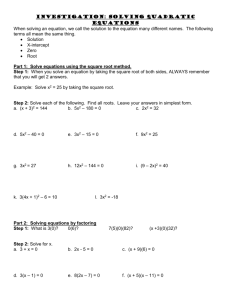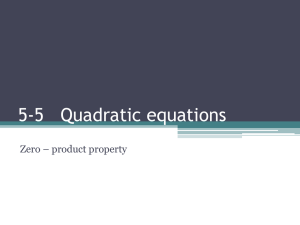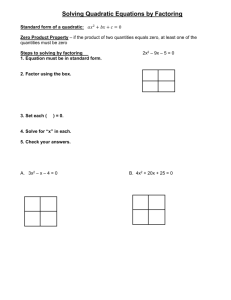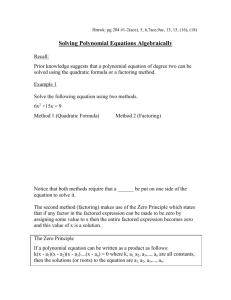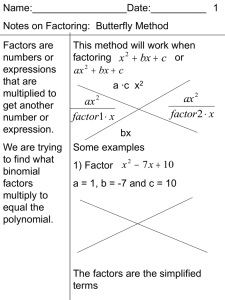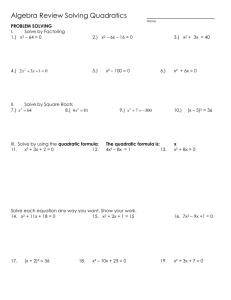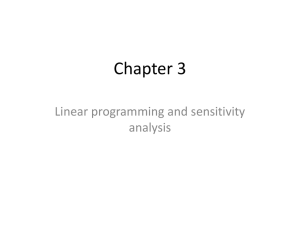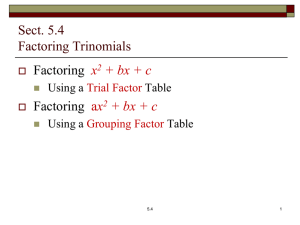chapter1problems
advertisement
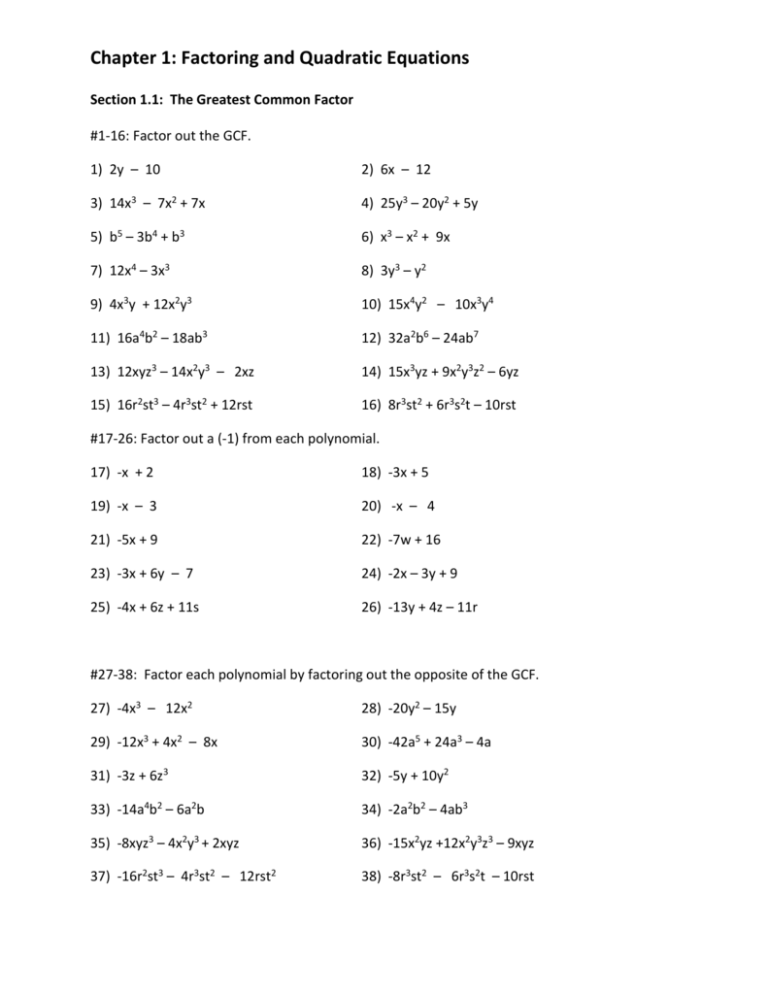
Chapter 1: Factoring and Quadratic Equations Section 1.1: The Greatest Common Factor #1-16: Factor out the GCF. 1) 2y – 10 2) 6x – 12 3) 14x3 – 7x2 + 7x 4) 25y3 – 20y2 + 5y 5) b5 – 3b4 + b3 6) x3 – x2 + 9x 7) 12x4 – 3x3 8) 3y3 – y2 9) 4x3y + 12x2y3 10) 15x4y2 – 10x3y4 11) 16a4b2 – 18ab3 12) 32a2b6 – 24ab7 13) 12xyz3 – 14x2y3 – 2xz 14) 15x3yz + 9x2y3z2 – 6yz 15) 16r2st3 – 4r3st2 + 12rst 16) 8r3st2 + 6r3s2t – 10rst #17-26: Factor out a (-1) from each polynomial. 17) -x + 2 18) -3x + 5 19) -x – 3 20) -x – 4 21) -5x + 9 22) -7w + 16 23) -3x + 6y – 7 24) -2x – 3y + 9 25) -4x + 6z + 11s 26) -13y + 4z – 11r #27-38: Factor each polynomial by factoring out the opposite of the GCF. 27) -4x3 – 12x2 28) -20y2 – 15y 29) -12x3 + 4x2 – 8x 30) -42a5 + 24a3 – 4a 31) -3z + 6z3 32) -5y + 10y2 33) -14a4b2 – 6a2b 34) -2a2b2 – 4ab3 35) -8xyz3 – 4x2y3 + 2xyz 36) -15x2yz +12x2y3z3 – 9xyz 37) -16r2st3 – 4r3st2 – 12rst2 38) -8r3st2 – 6r3s2t – 10rst Chapter 1: Factoring and Quadratic Equations Section 1.1: The Greatest Common Factor #39 – 52: Factor out the GCF 39) x(x-4) + 3(x-4) 40) x(x – 5) + 2(x – 5) 41) x2(y – 2) – 3(y – 2) 42) x2(x – 4) – 5(x – 4) 43) 3y(z + 1) – 4(z + 1) 44) 6y(z + 7) – 5(z + 7) 45) x(3x – 4) – 2(3x – 4) 46) x(5x + 1) – 4(5x+1) 47) 3x(2x – 7) + 4(2x – 7) 48) 5x(6x – 1) + 6(6x – 1) 49) 2x2(3x – 5y) – 5(3x – 5y) 50) 7x2(2x – 3y) – 4(2x – 3y) 51) 8y(y – 5) – 9(y – 5) 52) 7y(y+4) – 2(y+4) Chapter 1: Factoring and Quadratic Equations Section 1.2: Factoring by Grouping #1 – 36: Factor by Grouping, state if a polynomial is prime 1) x2 + 5x + 2x + 10 2) x2 + 3x + 4x + 12 3) x2 – 5x – 2x + 10 4) x2 – 3x – 4x + 12 5) x2 + 9x + 4x + 36 6) x2 + x + 36x + 36 7) x2 – 9x – 4x + 36 8) x2 – x – 36x + 36 9) y2 + 10y + 3y + 30 10) y2 + 6y + 5y + 30 11) y2 – 10y – 3y + 30 12) y2 – 6y – 5y + 30 13) 5x2 + 5x + 6x + 6 14) 5x2 +10x + 3x +6 15) 5x2 – 5x – 6x+ 6 16) 5x2 – 10x – 3x + 6 17) 4y2 + 3y + 4y + 3 18) 4y2 + 12y +y + 3 19) 4y2 – 3y – 4y + 3 20) 4y2 – 12y – y + 3 21) 2z2 – 2z + 7z – 7 22) 2z2 + 14z –z – 7 23) 2z2 + 7z – 2z – 7 24) 2z2 – 14z + z – 7 25) x3 + 2x2 + 6x + 12 26) y3 + 8y2 + 4y + 32 27) x3 + 6x + 3x2 + 18 28) z3 + 5z + 10z2 + 50 29) y3 + 4y2 + y + 4 30) x3 + 4x2 + x + 4 31) z3 + 5z2 – z – 5 32) x3 + 9x2 – x – 9 33) 5x3 + 4x2 + 10x + 8 34) 8x3 – 2x2 + 20x – 5 35) 7t3 + 5t2 + 21t + 15 36) 4x3 + 5x2 + 12x + 15 Chapter 1: Factoring and Quadratic Equations You have to know your multiplication tables very well for the next two sections. This table may help a bit. 12 1*12 2*6 3*4 24 1*24 2*12 3*8 4*6 34 1*34 2*17 46 1*46 2*23 58 1*58 2*29 70 1*70 2*35 5*14 7*10 82 1*82 2*41 14 1*14 2*7 25 1*25 5*5 35 1*35 5*7 48 1*48 2*24 3*16 4*12 6*8 60 1*60 2*30 3*20 4*15 5*12 6*10 72 1*72 2*36 4*18 8*9 100 1*100 2*50 4*25 5*20 10*10 15 1*15 3*5 26 1*26 2*13 36 1*36 2*18 3*12 4*9 6*6 50 1*50 2*25 5*10 62 1*62 2*31 74 1*74 2*37 121 1*121 11*11 16 1*16 2*8 4*4 27 1*27 3*9 38 1*38 2*19 52 1*52 2*26 4*13 63 1*63 3*21 7*9 75 1*75 3*25 5*15 144 1*144 2*72 3*48 4*36 18 1*18 2*9 3*6 28 1*28 2*14 4*7 40 1*40 2*20 4*10 5*8 54 1*54 2*27 3*18 6*9 64 1*64 2*32 4*16 8*8 76 1*76 2*38 4*19 169 1*169 13*13 20 1*20 2*10 4*5 30 1*30 2*15 3*10 5*6 42 1*42 2*21 3*14 6*7 55 1*55 5*11 65 1*65 5*13 77 1*77 7*11 225 1*225 15*15 3*75 5*45 9*25 21 1*21 3*7 32 1*32 2*16 4*8 44 1*44 2*22 4*11 56 1*56 2*28 4*14 7*8 66 1*66 2*33 3*22 6*11 78 1*78 2*39 3*26 6*13 22 1*22 2*11 33 1*33 3*11 45 1*45 3*15 5*9 57 1*57 3*19 68 1*68 2*34 4*17 80 1*80 2*40 4*20 5*16 8*10 6*24 8*18 9*16 12*12 Chapter 1: Factoring and Quadratic Equations Section 1.3: Factoring Trinomials of the Form x2 + bx + c #1 – 28: Rewrite as a polynomial with 4 terms (if possible) then factor by grouping and check your answer, state if a polynomial is prime. 1) x2 + 5x + 6 2) x2 + 7x + 6 3) x2 – 5x + 6 4) x2 – 7x + 6 5) y2 + 5y + 4 6) y2 + 4y + 4 7) y2 – 5y + 4 8) y2 – 4y + 4 9) z2 + 13z + 36 10) z2 + 15z + 36 11) z2 – 13z + 36 12) z2 – 15z + 36 13) x2 + 5x – 6 14) x2 + x – 6 15) x2 - 5x – 6 16) x2 – x – 6 17) x2 + 4x – 12 18) x2 + x – 12 19) x2 – 4x –12 20) x2 – x – 12 21) x2 + 7x + 2 22) x2 + 5x + 2 23) x2 – 7x + 2 24) x2 – 5x + 2 25) y2 + 3y – 11 26) y2 + 2y – 11 27) y2 – 3y – 11 28) y2 – 2y – 11 #29-58: Factor each trinomial without grouping, state if a polynomial is prime. 29) x2 + 11x + 18 30) y2 + 15y + 50 31) c2 + 12c + 20 32) b2 + 6b + 9 33) r2 + 6r + 8 34) x2 + 13x + 36 35) y2 – 10y +16 36) z2 – 7z + 12 37) x2 – 9x + 20 38) y2 – 5y + 6 Chapter 1: Factoring and Quadratic Equations Section 1.3: Factoring Trinomials of the Form x2 + bx + c #29 – 58 continued: 39) x2 – 2x + 3 40) y2 – 12y + 11 41) b2 + 4b – 5 42) a2 + 7a – 8 43) z2 + 5z – 6 44) z2 + 10z – 24 45) x2 + 4x – 12 46) x2 + 3x – 10 47) x2 – 2x – 15 48) y2 – 10y – 24 49) a2 – 9a – 22 50) a2 – 5a – 14 51) x2 – 6x – 16 52) x2 – 8x – 20 53) x2 + 2x + 8 54) x2 + 9x + 5 55) y2 – 2y + 5 56) y2 – 3y + 8 57) x2 – 5x – 9 58) x2 – 2x – 11 #59-74: Factor each trinomial. Make sure to factor out a negative or the GCF where applicable. 59) -x2 – 7x –10 60) -y2 – y + 30 61) -w2 + 18w – 77 62) –b2 + 14b – 33 63) 3x2 +12x – 36 64) 6y2 + 30y + 24 65) 6z2 – 30z + 24 66) 4x2 + 40x – 44 67) x3 + 6x2 – 7x 68) y3 – 5y2 + 6y 69) -2x3 – 10x2 + 12x 70) -2y3 – 10y2 + 48y 71) 20y + 18 + 2y2 72) 10y – 28 +2y2 73) 30z + 3z2 + 45 74) 9z + 3z2 – 54 Chapter 1: Factoring and Quadratic Equations Section 1.4: Factoring Trinomials in the Form ax2 + bx + c where a ≠ 1 #1 – 18: Rewrite as a polynomial with 4 terms (if possible) then factor by grouping and check your answer, state if a polynomial is prime. 1) 5x2 + 11x + 6 2) 5x2 +13x + 6 3) 5x2 – 11x + 6 4) 5x2 – 13x + 6 5) 4x2 + 7x + 3 6) 4y2 + 13y + 3 7) 4x2 – 7x + 3 8) 4y2 – 13y + 3 9) 2z2 + 5z – 7 10) 2z2 + 13z – 7 11) 2z2 – 5z – 7 12) 2z2 – 13z – 7 13) 6x2 + 23x + 7 14) 6x2 + 23x + 4 15) 3x2 + 10x + 7 16) 5x2 + 12x + 7 17) 5x2 + 13x + 6 18) 6x2 + 23x + 7 #19-44: Factor, using bottoms up or the guess and check method, state if a polynomial is prime (notice #19 – 30 are the same as #1-12, and you should get the same answer regardless of the technique you use to factor.) 19) 5x2 + 11x + 6 20) 5x2 + 13x +6 21) 5x2 – 11x + 6 22) 5x2 – 13x + 6 23) 4x2 + 7x + 3 24) 4y2 + 13y + 3 25) 4x2 – 7x + 3 26) 4y2 – 13y + 3 27) 2z2 + 5z – 7 28) 2z2 + 13z – 7 29) 2z2 – 5z – 7 30) 2z2 – 13z – 7 31) 3x2 – 11x + 10 32) 10x2 + 19x + 6 33) 2b2 – 15b + 7 34) 3w2 – 14w + 8 35) 6y2 – 7y – 5 36) 8y2 – 6y – 5 37) 8a2 + a – 7 38) 4x2 + 4x – 15 Chapter 1: Factoring and Quadratic Equations #19 – 44: Continued 39) 2x2 – 5x – 7 40) 8y2 – 5y – 3 41) 3x2 + 5x + 6 42) 7x2 + x + 3 43) 2x2 + 5x – 8 44) 3x2 + 7x + 8 #45-64: Factor out the GCF and then factor by bottoms up or the guess and check method. 45) 4m2 + 34m – 18 46) 15n2 + 36n + 21 47) 4z3 – 13z2 + 3z 48) 8x3 – 22x2 + 5x 49) 20x3 – 18x2 + 4x 50) 18y3 – 39y2 + 6y 51) -16x2 + 44x – 10 52) -20x2 + 18x – 4 53) 18x2 – 21x – 15 54) 16x2 – 12x – 10 55) 18x3 – 21x2 – 15x 56) 16x3 – 12x2 – 10x 57) -18x2 + 21x + 15 58) -16x2 + 12x + 10 59) 12x2 + 10x + 12 60) 21x2 + 3x + 9 61) 3x3 + 5x2 + 6x 62) 8y3 – 5y2 + y 63) 4b3 + 6b2 -6b 64) 8a3 + 12a2 – 6a Chapter 1: Factoring and Quadratic Equations Section 1.5: Factoring Sums and Differences of Squares #1- 42: Completely factor the binomials, remember to factor out the GCF first when applicable (if a problem is prime say so). 1) x2 – 9 2) y2 – 81 3) x2 + 9 4) y2 + 81 5) y2 – 36 6) b2 – 49 7) y2 + 36 8) b2 + 49 9) 25a2 – 81 10) 16b2 – 49 11) 25a2 + 81 12) 16b2 + 49 13) 49x2 – 36 14) 81x2 – 25 15) 49x2 + 36 16) 81x2 + 49 17) x3 – 64x 18) x5 – 121x3 19) x3 + 64x 20) x5 + 121x3 21) 3x2 – 27 22) 2b2 – 98 23) 3x2 + 27 24) 2b2 + 98 25) 9 – 25x2 26) 49 – 16y2 27) 81 – 16x2 28) 121 – 144x2 29) x4 – 9 30) x4 – 25 31) 16x4 – 25 32) 81x4 – 16 33) 98y2 – 2x4 34) 50x4 – 128y2 35) x4 – 16 36) y4 – 81 37) 2x4 – 512 38) 2x4 – 1250 39) y4 – 2401 40) y4 – 4096 41) x4 + 4 42) y2 + 9 Chapter 1: Factoring and Quadratic Equations Section 1.6: Factoring Sums and Differences of Cubes #1-42: Completely factor the binomials, remember to factor out the GCF first when applicable (if a problem is prime say so). 1) x3 + 8 2) y3 + 64 3) x3 – 8 4) y3 – 64 5) b3 + 27 6) x3 + 125 7) b3 – 27 8) x3 – 125 9) x3 + 64 10) y3 + 27 11) x3 - 64 12) y3 + 27 13) 8x3 – 27 14) 125x3 – 64 15) 8x3 + 27 16) 125x3 + 64 17) 27x3 – 125 18) 64x3 – 27 19) 64x3 – y3 20) 27x3 – y3 21) x6 – y3 22) y6 – x3 23) 27x6 – 1 24) 64x6 – 1 25) 125x9 – y6 26) 8x9 – y3 27) 16x3 – 54 28) 3x3 – 81 29) 3x3 + 24 30) 2x3 + 128 31) x4 – 8x 32) y4 – 64y 33) 6x4 – 48x 34) 3y4 – 192y 35) 8x5 + 125x2 36) 3x5 – 375x2 37) 27 – x3 38) 64 – y3 39) 27 + 64x3 40) 125 + 8x3 41) 8 + y6 42) 64 + x9 Chapter 1: Factoring and Quadratic Equations Section 1.7: A Review of all the Factoring Strategies – Mixed Up One of the hardest things about factoring is knowing which strategy to use. I will attempt to help you understand when to use a specific strategy as I go through this section with you. Here are a few tips that may help. 1) ALWAYS FACTOR OUT THE GCF FIRST IN EVERY FACTORING PROBLEM!!! If you don’t factor out the GCF it will likely be hard to determine which technique is needed to finish factoring. 2) Problems with 4 terms – FACTOR BY GROUPING. Here are a few examples of problems that I would factor by grouping. I will get more specific on how to factor these kinds of problems as I work through the section. x2 + 5x + 6x + 30 6y2 - 15y - 4y + 10 3) Problems with 3 terms – break these into two groups. The easier will contain the problems that do not have a number in front of the first term. The harder will have a number in front of the first term. (All problems with 3 terms can be factored using grouping, but I rarely use grouping to factor problems with three terms.) a) Problems with 3 terms that do not have a number in front of the first term. You can immediately create two parenthesis and put in the firsts and the signs. You will need to make a table to determine the lasts. Problems in original problem Signs in the factored answer + + ( + )( + ) - + ( - )( - ) + ( + )( - ) ( + )( - ) A trick to remember this is if the second sign in the original problem is minus you get one parenthesis with a plus and one with a minus. If the second sign in a problem is plus you get the same sign in each parenthesis, and you refer back to the first sign. Here are a few examples of problems that fit this category. x2 + 5x – 6 y2 – 3y + 2 Chapter 1: Factoring and Quadratic Equations Section 1.7: A Review of all the Factoring Strategies – Mixed Up b) Problems with 3 terms that have a number in front of the first term. Use BOTTOMS UP The steps for bottoms up Multiply Factor Divide / Reduce / Bottoms Up Here are a few examples of problems that fit this category. 3x2 + 4x – 7 5y2 – 14y + 8 4) Problems with 2 terms. First classify the problem as a square or a cube. a) Square problems have letters with exponents that are multiples of 2, such as x 2, y4, z6. They have numbers that are perfect squares such as 1, 4, 9, 16, 25, 49… i) Square problems with a plus sign are called sums of squares and are prime. Here are a few examples of problems that fit this category. 9x2 + 16 y2 + 49 ii) Square problems with a minus sign are called difference of squares and they factor. You divide the exponent of any letter by 2 and square root any number. Then create two essentially identical parenthesis. Here are a few examples of problems that fit this category. 9x2 - 16 y2 - 49 b) Cube problems have letters with exponents that are multiples of 3, such as x3, y6, z9. They have numbers that are perfect cubes such as 1, 8, 27, 64, 125. Cube problems with plus signs and minus signs both factor. The signs you put in the parenthesis are found by S.O.P. (same, opposite, plus). We then write what makes each piece a cube the put one of each in the first parenthesis and pair them up for the second parenthesis. Here are a few examples of problems that fit this category. x3 + 64 125y3 – 8 27x6 – 8x9 Chapter 1: Factoring and Quadratic Equations Section 1.7: A Review of all the Factoring Strategies – Mixed Up #1-44: Factor completely, state if a polynomial is prime. 1) a2 + 16 2) b2 + 25 3) 81y2 – 4 4) 121x2 – 144 5) b3 + 64 6) x3 + 1 7) 64x3 – 1 8) 27x3 – 64 9) 2x2 – 3x – 9 10) 8y2 – 10y – 3 11) -4x2 + 6x + 18 12) -16x2 + 20x + 6 13) 3x2 – 13x + 10 14) 5x2 – 23x + 12 15) -w2 + 8w – 15 16) –b2 + 7b – 12 17) x2 – 2x + 15 18) y2 – 10y + 24 19) 5x2 + 10x + 6x + 12 20) 5x2 +30x + 3x +18 21) x2 + 5x + 9 22) x2 + 4x + 7 23) 6x4 – 6x 24) 3y4 – 3y 25) 2x2 – 8 26) 3b2 – 12 27) 3x2 + 12 28) 2b2 + 8 29) 3x2 – 5x – 6x + 10 30) 2x2 – 3x – 8x + 12 31) x2 + x + 24x + 24 32) x2 + x + 12x + 12 33) 6x2 + 13x + 6 34) 2x2 + 9x + 9 35) -x2 + 5x + 6 36) -x2 – 5x + 6 37) -3x2 – 12x +36 38) -6y2 – 30y – 24 39) z2 – 5z + 4 40) x2 + 10x – 11 41) x2 – 14x – 15 42) y2 – 23y – 24 43) a2 – a – 2 44) a2 – 2a – 3 Chapter 1: Factoring and Quadratic Equations Section 1.8 Solving Quadratic Equations by Factoring #1 - 21: Solve each equation. 1) (x – 3)(x + 2)=0 2) (x + 3)(x – 5) = 0 3) (x – 1)(x – 7) = 0 4) (x – 9)(x – 10)=0 5) (3x + 12)(2x – 8) = 0 6) (2x – 12)(3x + 15) = 0 7) (2x – 9)(3x + 10)=0 8) (5x + 4)(2x – 3) = 0 9) (5x – 7)(3x – 11) = 0 10) 3x(x – 4)(x + 5)= 0 11) 7x(x – 1)(x + 2) = 0 12) 4x(2x – 10)(3x + 15) = 0 13) 5x(2x + 10)(4x + 20) = 0 14) x(x + 1)(x + 2) = 0 15) x(x – 3)(x + 5) = 0 16) x(7x – 10)(3x – 16) = 0 17) 7(x – 1)(x – 2) = 0 18) 4(x – 3)(x + 5) = 0 19) 2(5x – 30)(3x + 18) = 0 20) 11(4x – 1)(3x–5) = 0 21) 6(2x – 9)(5x – 1) = 0 #22 - 42: Solve each equation. 22) x2 – 5x + 6 = 0 23) x2 – 14x + 45 = 0 24) x2 + 6x – 7 = 0 25) x2 – 5x – 6 = 0 26) y2 – 81 = 0 27) b2 – 25 = 0 28) 25x2 – 16 = 0 29) 49y2 – 16 = 0 30) 3x2 + 5x + 2 =0 31) 5x2 + 9x + 4 =0 32) 2x2 + 3x + 1 = 0 33) 3x2 – 5x – 2 = 0 34) 5x2 + 12x + 4 =0 35) 2x2 + 5x + 3 = 0 36) 3x2 – x – 2 = 0 37) x2 – x – 6 = 0 38) x2 + 11x + 10 = 0 39) 25y2 – 81 = 0 40) 16b2 – 25 = 0 41) 3y2 + 5y – 2 = 0 42) 6x2 – x – 5 = 0 Chapter 1: Factoring and Quadratic Equations Section 1.8 Solving Quadratic Equations by Factoring #43 - 60: Solve each equation. (Remember to factor out the GCF first) 43) 3x3 + 5x2 + 2x = 0 44) 10x3 + 18x2 + 8x = 0 45) 4x2 + 2x – 6 = 0 46) 3x2 + 18x – 21 = 0 47) 5x2 – 20 = 0 48) 2x2 – 18 = 0 49) 3x3 – 15x2 + 18x = 0 50) 2x3 – 28x2 + 90x = 0 51) 3x2 – 15x – 18 = 0 52) 2x2 – 28x + 90 = 0 53) 10x2 + 18x + 8 = 0 54) 14x2 + 35x + 21 = 0 55) 10x3 + 18x2 + 8x = 0 56) 14x3 + 35x2 + 21x = 0 57) -2x2 +10x + 12 = 0 58) -3x2 – 18x + 21 = 0 59) x3 – 49x = 0 60) y3 – 25y = 0 #61 - 78: Solve each equation. 61) r(r + 1) = 12 62) x(x – 1) = 6 63) x(x – 4) = -3 64) y(y – 5)= -4 65) (x – 2)(x – 3)= 6 66) (x – 1)(x– 2) = 12 67) (x + 1)(x – 4) = 6 68) (z + 3)(z – 4) = 8 69) 3x(x + 1) = 6 70) 4x(x – 4) = -12 71) (2x – 3)(x + 2) = 4 72) (3x – 4)(x – 5) = -6 73) x(x – 3) +2 = 30 74) 3x(x – 1) – 4 = 2 75) 2x(x – 3) = 5x(x– 4) +8 76) 2(3 – 4x) = x(x – 1) – 2 77) x(x – 4) + 1 = x + 7 78) x(x – 3) + 4 = 3x – 4 Chapter 1: Factoring and Quadratic Equations Section 1.9: Applications that involve factoring 1) A number is 20 less than its square. Find all such numbers. 2) A number is 12 less than its square. Find all such numbers. 3) The square of a number is 6 more than the number. Find all such numbers. 4) The square of a number is 12 more than the number. Find all such numbers. 5) The product of two consecutive numbers is 72. Find all such numbers. 6) The product of two consecutive numbers is 20. Find all such numbers. 7) The product of two consecutive even numbers is 24. Find all such numbers. 8) The product of two consecutive even numbers is 48. Find all such numbers. 9) The product of two consecutive odd numbers is 63. Find all such numbers. 10) The product of two consecutive odd numbers is 15. Find all such numbers. 11) The length of a rectangular bedroom is 2 feet longer than its width. The area of the bedroom is 120 square feet. Find the dimensions of the room. 12) The length of a rectangular bedroom is 3 feet longer than its width. The area of the bedroom is 108 square feet. Find the dimensions of the room. 13) A rectangular garden is 4 feet narrower than it is long. The garden has an area of 32 square feet. Find the dimensions of the garden. 14) A rectangular garden is 3 feet narrower than it is long. The garden has an area of 54 square feet. Find the dimensions of the garden. 15) The base of a triangle is 2 feet longer than its height. The area of the triangle is 7.5 square feet. Find the height of the triangle. 16) The base of a triangle is 1 foot longer than its height. The area of the triangle is 10 square feet. Find the height of the triangle. Chapter 1: Factoring and Quadratic Equations Section 1.9: Applications that involve factoring 17) The height of a triangle is 2 feet shorter than its base. The area of the triangle is 17.5 square feet. Find the height of the triangle. 18) The height of a triangle is 3 feet shorter than its base. The area of the triangle is 20 square feet. Find the height of the triangle. 19) The length of the hypotenuse of a right triangle is 8 inches more than the shortest leg. The length of the longer leg is 7 inches more than the length of the shorter leg. Find the length of each side of the triangle. 20) The length of the hypotenuse of a right triangle is 4 inches more than the shortest leg. The length of the longer leg is 2 inches more than the length of the shorter leg. Find the length of each side of the triangle. 21) The length of a hypotenuse of a right triangle is 1 foot more than the longer leg. The length of the shorter leg is 1 foot less than the length of the longer leg. Find the length of each side of the right triangle. 22) The length of a hypotenuse of a right triangle is 2 foot more than the longer leg. The length of the shorter leg is 2 foot less than the length of the longer leg. Find the number length of each side of the right triangle. 23) The length of the hypotenuse in a right triangle is 15 inches. The shortest leg is 3 inches shorter than the length of the longest leg. Find the length of each of the legs. 24) The length of the hypotenuse in a right triangle is 10 inches. The shortest leg is 2 inches shorter than the length of the longest leg. Find the length of each of the legs. 25) The length of the short leg in a right triangle is 3 inches. The longest leg is 1 inch less than the length of the hypotenuse. Find the length of each of the each unknown side. 26) The length of the short leg in a right triangle is 5 inches. The longest leg is 1 inch less than the length of the hypotenuse. Find the length of each of the each unknown side. Chapter 1: Factoring and Quadratic Equations Chapter 1: Review 1) Completely factor the polynomial. State if a polynomial is prime. a) x2 + 7x – 18 b) z2 – 13z + 36 c) -y2 +5y + 14 d) -2y3 – 10y2 + 48y e) 6x2 + 13x + 5 f) x2 + 2x + 3 g) 9n2 + 24n + 15 h) 4x3 – 16x2 – 84x i) 25b2 – 81 j) x2 + 64 k) x3 + 125 l) 27y3 – 64 m) 5m2 + m – 6 n) 3n2 + 7n +2 o) -3x3 – 21x2 + 54x p) 2b2 + 3b + 5 q) x2 + 5x + 2x + 10 r) 5x2 + 10x – 3x – 6 2) Solve each equation. a) 2x(x – 3) = 0 b) (x + 2)(3x – 10)=0 c) x2 – 3x – 10 = 0 d) 5x2 + 16x + 3 =0 e) x(x – 1) = 20 f) x(x + 1) = 20 g) a2 – 49 = 0 h) 25b2 = 16 i) 2x2 + 3x + 1 = 0 j) x(x – 2) = 0 k) y2 + 6y + 9 = 0 l) b2 + 6b = 7 3) The product of two consecutive numbers is 30. Find all such numbers. 4) A rectangular garden is 3 feet narrower than it is long. The garden has an area of 70 square feet. Find the dimensions of the garden. 5) The length of the hypotenuse in a right triangle is 5 inches. The shortest leg is 1 inch shorter than the length of the longest leg. Find the length of each of the legs. Chapter 1: Factoring and Quadratic Equations Grima, Mat 120 chapter 1 Hybrid practice test 1 – 12: Completely factor the polynomial. State if a polynomial is prime. 1) x2 + 2x – 24 2) -3y3 – 6y2 + 9y 3) 2n2 + 11n + 5 4) 16x2 – 25 5) x2 + 25 6) x3 + 8 7) 5m2 + m – 4 8) 3n2 – n - 2 9) x2 + 5x + 6x + 30 10) 4x2 – 2x - 10x + 5 11) x3 – 125 12) x2 + 3x + 7 13 – 18: Solve each equation. 13) (x + 2)(3x + 24)=0 14) x2 – 7x – 18 = 0 15) 5x2 - 8x + 3 =0 16) x(x – 3) = 10 17) 5x2 + 3x - 2 = 0 18) 2x(x +4) = 0 19) A rectangular garden is 2 feet narrower than it is long. The garden has an area of 35 square feet. Find the dimensions of the garden. 20) The length of the hypotenuse in a right triangle is 5 inches. The longest leg is 1 inch longer than the length of the shortest leg. Find the length of each side. Answers: 1) (x + 6)(x – 4) 2) -3y(y+3)(y – 1) 3) (2n+1)(n+5) 4) (4x + 5)(4x – 5) 5) prime 6) (x + 2)(x2 – 2x + 4) 7) (5m – 4)(m + 1) 8) (3n + 2)(n – 1) 9) (x+5)(x+6) 10) (2x – 5)(2x – 1) 11) (x – 5)(x2 + 5x + 25) 12) prime 3 2 13) x = -2, -8 14) x = -2,9 15) x = 5 , 1 16) x = -2, 5 17) x = 5 , −1 18) x = 0,-4 19) width 5 ft length 7 ft 20) short let 3 inches long leg 4 inches
